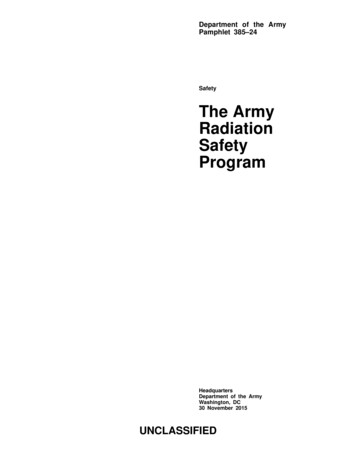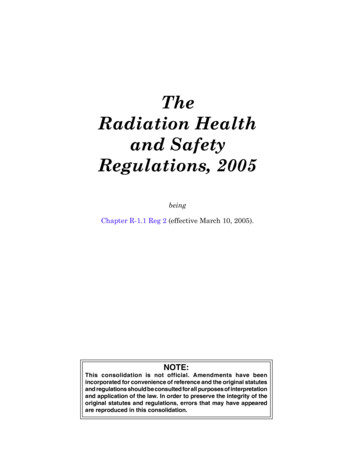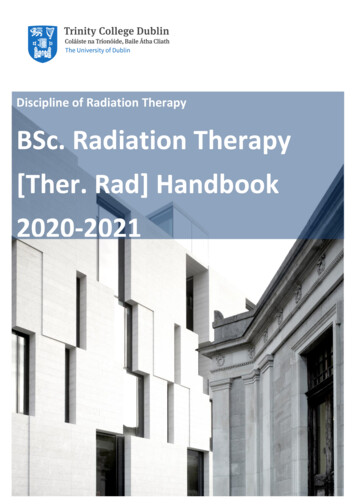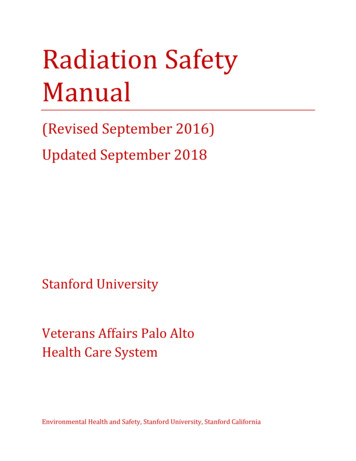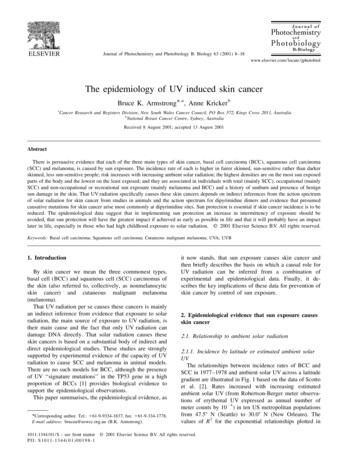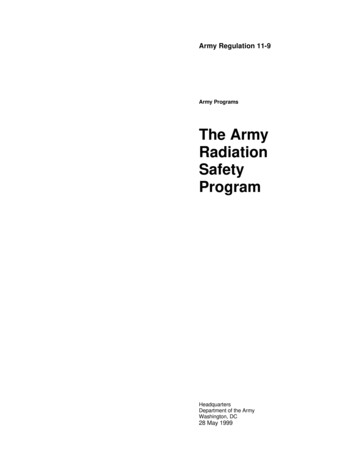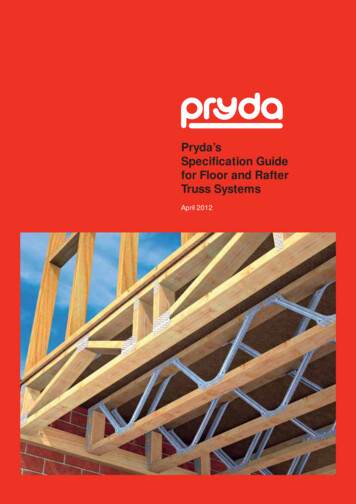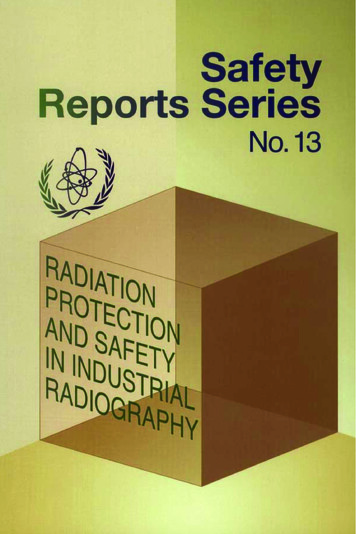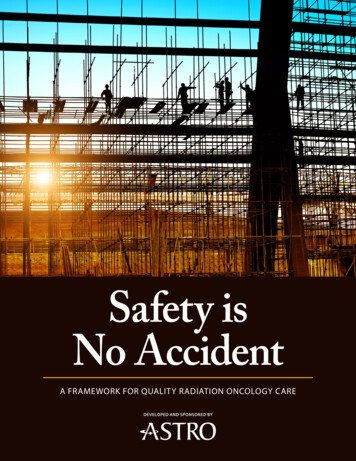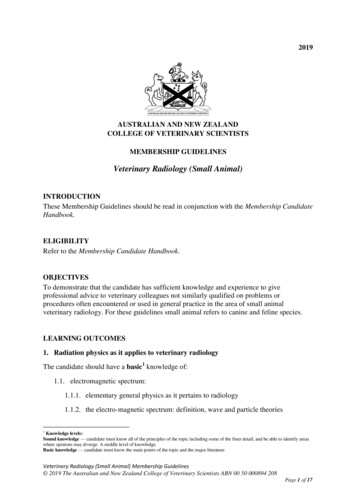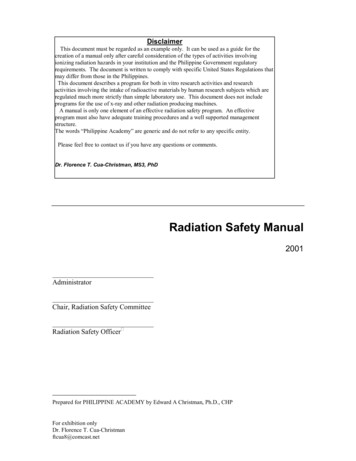
Transcription
DisclaimerThis document must be regarded as an example only. It can be used as a guide for thecreation of a manual only after careful consideration of the types of activities involvingionizing radiation hazards in your institution and the Philippine Government regulatoryrequirements. The document is written to comply with specific United States Regulations thatmay differ from those in the Philippines.This document describes a program for both in vitro research activities and researchactivities involving the intake of radioactive materials by human research subjects which areregulated much more strictly than simple laboratory use. This document does not includeprograms for the use of x-ray and other radiation producing machines.A manual is only one element of an effective radiation safety program. An effectiveprogram must also have adequate training procedures and a well supported managementstructure.The words “Philippine Academy” are generic and do not refer to any specific entity.Please feel free to contact us if you have any questions or comments.Dr. Florence T. Cua-Christman, MS3, PhDRadiation Safety Manual2001AdministratorChair, Radiation Safety CommitteeRadiation Safety OfficerPrepared for PHILIPPINE ACADEMY by Edward A Christman, Ph.D., CHPFor exhibition onlyDr. Florence T. Cua-Christmanftcua8@comcast.net
EMERGENCY PROCEDURESIN CASE OF FIRE, INJURY OR OTHER EMERGENCY WHERERADIOACTIVITY MAY BE INVOLVED:1. CALL xxx. State the nature of the emergency, the locationand your name and the extension at which you can bereached. State that radioactive materials may be involved2. QUALIFIED PERSONS SHOULD TREAT A SERIOUS INJURYOR FIRE WITHOUT REGARD TO THE POSSIBLE PRESENCEOF RADIOACTIVITY. HOWEVER, TAKE PRECAUTIONS TOPREVENT THE SPREAD OF ANY RADIOACTIVECONTAMINATION THAT MAY BE PRESENT.3. CALL THE RADIATION SAFETY OFFICER. (xxx) xxx-xxxx4.For additional information see the emergency response procedures in themanual and the Philippine Academy emergency response procedures.For exhibition onlyDr. Florence T. Cua-Christmanftcua8@comcast.neti
Table of ContentsEMERGENCY PROCEDURESIN CASE OF FIRE, INJURY OROTHER EMERGENCY WHERE RADIOACTIVITY MAY BE INVOLVED: . iTable of Contents . iiPhilippine Academy Radiation Safety Policy. 1Introduction. 1The PHILIPPINE ACADEMY Radiation Safety Program Structure. 2The Professional Standards for the Program . 5Annual Review and Audit of the Program . 5Security of Radiation Sources . 6Acquisition of a Radiation Source . 6Authorization to Use a Radiation Source . 6Security of Radiation Sources . 8Standard operating procedures for the use of unsealed sources of radioactive materials(both medical and non-medical uses). . 9Standard Procedures for Medical (Human Use) of Radioactive Materials . 13The Quality Management Program for Therapeutic Administrations of RadioactiveMaterials. . 14Provision of Information to Patients at Release . 16Response to Spills, Fire and Other Emergencies . 17Standard operating procedures for sealed sources. 19Education and Training . 20Personal Radiation Dose Limits and Personal Monitoring . 21Radiation Dose Limits. 22Appendices . 24The PHILIPPINE ACADEMY Radiation Safety Committee . 26Appendix II Application to use Radioisotopes (Non-Human Use) . 28PHILIPPINE ACADEMY Application to use Radioisotope(s) (non-human use) . 29Experience Relevant to Use of Proposed Material . 30Appendix III Application for Human Use of Radioactive Materials. 28(Insert protocol blank form here). 29Appendix IV The PHILIPPINE ACADEMY Quality Management Program. 29Appendix V The PHILIPPINE ACADEMY Patient Release Information Form . 30For exhibition onlyDr. Florence T. Cua-Christmanftcua8@comcast.netii
Appendix VI Declaration of Pregnancy Form. 31Appendix VII Radioactive Material Receipt, Inventory and Disposal Forms . 33Appendix VIII Laboratory Contamination Survey Form . 31Appendix IX Survey Record for Sealed Sources of Radioactivity. 33Appendix X Using Radioactive Materials in the Animal Care Facility. 34Appendix XI PHILIPPINE ACADEMY Licenses to Possess and Use RadioactiveMaterials . 36Appendix XII References and Information about Specific Radionuclides . 38Frequently used vendors of radioactive materials and radiation safety Equipment . 39APPENDIX XIII Records and Reports that must be kept . 40Glossary . 42INDEX . 47For exhibition onlyDr. Florence T. Cua-Christmanftcua8@comcast.netiii
The Philippine Academy Radiation Safety PolicyThe use of all ionizing radiation sources in the PHILIPPINE ACADEMY must be suchthat radiation exposures to those using the sources and other PHILIPPINE ACADEMYemployees, to patients, members of the public and to the environment are kept as low asreasonably achievable.The PHILIPPINE ACADEMY complies with all relevant governmental regulations andthe current professional standards.IntroductionThe PHILIPPINE ACADEMY uses radioactive materials in two major activities, thediagnosis and treatment of patients ("human use") and as one of many tools in laboratoryresearch activities ("non-human use"). Although there are similarities in the requirementsand precautions for these different activities, there are also important differences.The ACADEMY Radiation Safety program covers both of these activities. It also haspolicies and procedures specific to each. Each individual using radioactive materialsunder any of the ACADEMY's regulatory licenses must be familiar with the policies ofthe Radiation Safety Program and comply with all of the relevant procedures.This manual reflects the differing nature and concerns of human use and non-human useof radioactive materials. Some sections refer to one of the activities, some cover both. Itenunciates the policies of the Radiation Safety Program and contains information andmaterials to assist users in complying with them. This information includes: the application and procedure for the use of radioactive materialsguidance for precautions that must be taken when using this sourcesprocedures that are required for compliance to the governmental regulationsprocedures for the disposal of radioactive materialsYou should read this manual and become familiar with the sections that are relevant toyour needs and activities. Keep it with your other administrative information. If yousupervise others who use ionizing radiation sources, you must also make the manualavailable to them.If you have questions or concerns about the manual or the radiation safety program,please contact the Radiation Safety Officer or the Radiation Safety Committee Chair.The Philippine Academy Licenses and PermitsThe ACADEMY has obtained a "specific license of broad scope" (License No. 29-2855401; a copy is in Appendix X) from the US Nuclear Regulatory Commission (NRC) whichpermits the possession and use of a variety of by-product materials in both medical(human use) and non-medical applications. A similar license (No. 20390/00/008) hasbeen obtained from the NJ Department of Environmental Protection (NJDEP) forFor exhibition onlyDr. Florence T. Cua-Christman, MS3, PhDftcua8@comcast.net1
naturally occurring and accelerator produced radioactive isotopes, which are regulated bythe State of New Jersey. Only materials that are listed on these licenses may be used inthe ACADEMY. All uses must comply with the license conditions and regulations. Thelicenses may be amended to include new radionuclides but the process can result insubstantial delays in the approval process. Use of these sources must comply with therelevant federal regulations including 10CFR Parts, 19, 20, 30, 35 and NJAC 7:28.Copies of the regulations are available in the Radiation Safety Office and the websites ofthe NRC (www.nrc.gov) and the NJ DEP ( www.state.nj.us/dep/rpp ).Copies of these licenses are posted on bulletin boards in these locations: The hallway near the Clinic Office (1st floor) The hallway in the radiolabeling facility (1st floor) The Radiation Safety Office (1st floor)The State of New Jersey regulations (NJAC 7:28) require that any device capable ofproducing ionizing radiation, for example x-ray machines or particle accelerators, beregistered with the NJ Department of Environmental Protection (NJ DEP). Theregistrations are renewed annually and devices must be checked annually to insure thatthey do not result in radiation doses to the users and others.Inspectors from the NRC and the NJ DEP occasionally visit the ACADEMY to monitorcompliance to the regulations, license and permit conditions. The ACADEMY may besubject to fines and citations if violations are observedEmployees of the ACADEMY have the right to report a violation of NRC regulations orNJ DEP regulations to the respective agency and to request inspections. Any user whobelieves that a violation of the regulations or license conditions exists or has occurred inlicense activities with regard to radiological working conditions in which the worker isengaged, may request an inspection by giving notice of the alleged violation to the NRCor any NRC inspector (or to the NJ DEP or its inspectors). Any such notice shall be inwriting, shall set forth the specific grounds for the notice, and shall be signed by the user.Additional information about these rights is found on the notices posted at the employees’entrance and outside the Radiation Safety Office.The PHILIPPINE ACADEMY Radiation Safety Program StructureThe Radiation Safety program is designed to use, to the extent practical, procedures andengineering controls based upon sound radiation protection principles to ensure that alloccupational exposures and doses to members of the public that are as low as isreasonably achievable (ALARA). It also ensures that the PHILIPPINE ACADEMYcomplies with the relevant governmental regulations and the current professionalstandards.The radiation safety program has four levels of responsibility:For exhibition onlyDr. Florence T. Cua-Christman, MS3, PhDftcua8@comcast.net2
The Individual UserThe Authorized InvestigatorThe Radiation Safety OfficerThe Radiation Safety CommitteeIndividual usersScientists, physicians, laboratory technicians, and other research, clinical and supportpersonnel, engaged in activities involving the actual use of ionizing radiation sources,both radioactive materials and machine sources. These individuals must be trainedadequately for the hazard they may encounter and adhere to the approved procedures foreach of the sources. They must work under the supervision of an Authorized User.Visiting scientists, summer college and high school students and others workingtemporarily in the laboratory must also be adequately trained, obtain and use theappropriate dosimeters, and observe the precautions and procedures of the radiation safetyprogram. Minors, those under 18 years old, may work in the laboratory but are subject tomuch lower permissible dose limits under the NRC and NJ DEP regulations.Users who are or may be pregnant may also work with the sources. If they declare thepregnancy to the RSO in writing, they are subjected to lower regulatory permissible doselimits.Authorized UsersAuthorized Users are typically, scientists and physicians with training and experiencesuch that they are authorized by the Radiation Safety Committee to possess and usespecific sources of radiation. Working with the RSO, Authorized Users must plan eachuse of the source such that the exposure to those involved is kept at acceptable levels andas low as possible. They must adequately train those involved and provide the equipmentand materials required. They must ensure compliance with the Radiation Safety Programprocedures.The Authorized User must ensure the security of the radioactive materials or machinesources at all times by restricting access to those who are adequately trained andinformed.Specifically, the Authorized User must: Perform radiation surveys and contamination surveys in all authorized restricted areasoften enough to demonstrate that these areas are free of unnecessary radiation fieldsand radioactive contamination. Surveys must be conducted at least monthly wheneverradioactive material is in use. The appropriate units (e.g., Bq (µCi) for radioactivitymeasurements, C Kg-1 hr-1 for radiation field intensity cGy (mrads) for absorbed dosemust be used in the records of all surveys. The records must be maintained for thelife of the license and are subject to inspection by the RSO and regulatory inspectors. Keep a current inventory of all radioactive materials for which he or she is responsiblereleased down the drain.For exhibition onlyDr. Florence T. Cua-Christman, MS3, PhDftcua8@comcast.net3
Educate and train each user working under the Authorization at a level adequate forthe hazards encountered.Train and closely supervise all visitors and others working temporarily in thelaboratories, especially those under 18 years old.Enforce the policies and procedures of the Radiation Safety Program in the authorizedrestricted areas.The Radiation Safety Officer (RSO)The RSO has the responsibility for the implementation and management of the RadiationSafety Program, including the upkeep of all documentation and records necessary todemonstrate compliance to the ACADEMY policies and government regulations. Acopy of the Memo delegating authority to the current RSO is in Appendix I. The RSOmay delegate these activities to complete them efficiently, but retains the fullresponsibility for them. Typical activities include: Receiving, delivering and shipping from the ACADEMY all radioactive materialsMaintaining an inventory of all sourcesOperating the ACADEMY radiolabeling suiteMonitoring the use of these materials both in the radioisotope suite and in other areasMonitoring individual users by provision of dosimeters or bioassay when appropriateProviding instruction and training about the appropriate procedures and precautionsfor the use of the sources to individual usersProviding training and education to maintenance, custodial, security staff membersand other persons who may need to enter the restricted laboratoriesProviding general "awareness" information to secretarial, clerical and other staffmembers.Providing instructions to patients and their familiesSupervising and coordinating the disposal of radioactive wastePerforming leak tests on all sealed sourcesSupervising the clean up of spills of radioactive materialsMaintaining the necessary survey instrumentation and other equipment in properoperating condition and in calibrationActing as liaison with the NRC, NJ DEP and other regulatory agencies when radiationsources are involvedImplementing program changes suggested as a result of the annual program auditand/or required by changes in the regulations or license conditions.The RSO also provides technical assistance to ensure that the uses of the radiationsources do not result in unwarranted and unnecessary exposure to radiation and to ensurecompliance with program policies and procedures.The Radiation Safety CommitteeThe Radiation Safety Committee recommends policies and procedures of the RadiationSafety program to senior management. The committee approves of all proposed uses ofradiation sources, provides technical assistance to the Radiation Safety Officer (RSO) andFor exhibition onlyDr. Florence T. Cua-Christman, MS3, PhDftcua8@comcast.net4
oversees the quality of the implementation of the program. The Committee reports to theVice President of PHILIPPINE ACADEMY. The committee meets every three monthsbut may meet more frequently if necessary to transact its business. The Committee Chairmaintains minutes of each meeting for the life of the ACADEMY's licenses.Appointed by the Senior Management, the Committee is composed of experts in radiationprotection, the Radiation Safety Officer, representatives of the user community andACADEMY management representatives with responsibilities that affect the radiationsafety program. The Chair of the Committee is the Director of Clinical ResearchAdministration; the RSO is the Executive Secretary. The current membership of thecommittee is shown in Appendix I.The committee reviews all proposed uses of ionizing radiation to determine that theycomply with the policies and procedures of the Radiation Safety Program and that allexposures to radiation are kept as low as reasonable achievable. No work withradioactive material can proceed without the prior approval of the committee or theRadiation Safety Officer, acting as its agent.The Committee may authorize the RSO to act as its agent in routine approval and reviewactivities. However, it has the final responsibility for the implementation andmanagement of the program.The Committee reviews all instances of alleged infractions of the policies and procedureswith the RSO and the responsible management before submitting reports andrecommendations to the senior management. It also adjudicates any differences arisingbetween Authorized Users and the Radiation Safety Officer.The Professional Standards for the ProgramThe standards of the following organizations are used as a basis for the PHILIPPINEACADEMY program. Each organization maintains an Internet web site listing itsactivities and publications as well as links to additional interesting and useful web sitesabout radiation and radiation protection. National Council on Radiation Protection and Measurements (NCRP)American Association of Physicists in Medicine(AAPM)American Board of Radiology (ABR)International Committee on Radiation Protection (ICRP)International Atomic Energy Agency (IAEA)The Health Physics Society (HPS)Annual Review and Audit of the ProgramA federal regulation requires that a formal audit of the Radiation Safety Program beconducted at least once every twelve-month period. The Radiation Safety Manual isFor exhibition onlyDr. Florence T. Cua-Christman, MS3, PhDftcua8@comcast.net5
reviewed and updated after the Audit is completed. The Committee Chair keeps copiesof each Annual Audit report for the life of the licenses.Security of Radiation SourcesA key tenet of the radiation safety program is to ensure that only authorized and properlytrained individuals are permitted access to sources of radiation.Acquisition of a Radiation SourceThe Radiation Safety Committee, through its agent, the RSO, must approve the purchase,lease, donation, or other acquisition of any source of ionizing radiation. Contact theRadiation Safety Officer well before you acquire any source so that any adjustments tothe ACADEMY's NRC license or regulatory permits can be made. For example, it takesabout four weeks to add a radionuclide not already listed to the license.All purchased radioactive materials sources must use a purchase requisition signed by theRSO. The requisition must contain the name of and be signed by the Authorized User.Blanket and standing orders must have the prior approval of the RSO.All radioactive material sources, purchased or otherwise acquired, must be shipped to thisaddress during normal business hours (7:00 a.m. to 5 p.m., M-F):Philippine Academy(address)Attention: Radiation Safety Officer (name) RSODeliveries at other times must have the prior approval of the RSO. When the source isdelivered, the RSO will check the shipment for possible contamination, review theaccompanying shipping documentation for compliance to the regulations and initiate theinternal inventory tracking documentation before releasing the shipment to the authorizeduser.Authorization to Use a Radiation SourceUsing these procedures will provide to the Radiation Safety Committee with thenecessary information to evaluate the proposed use of the source(s) with minimumburden to both the Committee and prospective authorized user.Human (Medical) Use of radio-labeled pharmaceuticals and other chemicalsubstances.A physician who has the appropriate training and experience in the use of the materialsmust supervise human administration of radioactive material. The specific requirementsfor the training and experience are delineated in the NRC regulations (10 CFR 35;Subpart J). Unless the administration is explicitly listed in 10 CFR 35, the RadiationSafety Committee must approve a complete proposed clinical protocol before anyhuman use of radioactive materials. (See Appendix III for procedural details).For exhibition onlyDr. Florence T. Cua-Christman, MS3, PhDftcua8@comcast.net6
The proposal, which must include an approved Institutional Review Board (IRB)protocol, should be submitted to the Chair of the Radiation Safety Committee. TheRadiation Safety Committee will consider the recommendations of its Human Usesubcommittee and the RSO during its evaluation. (IRB). The protocols are reviewed forrenewal annually.Unsealed Radioactive Materials (non-medical use).Complete the appropriate application (Appendix IV), with the assistance of the RSO ifnecessary, and send it to the RSO. The RSO will present the complete application to theCommittee for review with recommendations. In some cases, when the activitiesinvolved are relatively uncomplicated, the RSO, acting as agent for the Committee mayapprove the proposal subject to a final review by the Committee. No work may beginuntil the Committee issues a formal approval.The authorizations are approved for a two-year period and can be renewed. TheCommittee must approve any significant changes in the approved activities beforeimplementation.The authorizations are terminated if an Authorized User leaves employment with theACADEMY or ends the use of radioactive materials. All sources of radioactivity,including radioactive waste must be transferred to the RSO or placed under the control ofanother active Authorization before an Authorization is ended. A final survey of allrestricted areas controlled exclusively by the Authorization, showing the areas to be freeof contamination by the authorized materials, must be submitted with a written requestfor termination.An Authorization can also be terminated by the Radiation Safety Committee for repeatedfailure to comply with the Policies and Procedures of the Radiation Safety Program by theAuthorized User or one of the workers under the authorization. This termination maytake place after a sequential chain of actions:1. An informal verbal or written warning by the RSO or a designated person2. A formal notice of violation issued by the RSO with copies to the Radiation SafetyCommittee and the Authorized Users immediate superior.3. A formal hearing by the Radiation Safety Committee4. A formal vote by the Committee on remedial action(s)The Radiation Safety Committee acts as the final adjudicator in all disputes aboutRadiation Safety in the ACADEMY.Sealed Radioactive Material Sources (e.g., an electron capture detector for a gaschromatograph or check sources, flood sources)The person responsible for the source must be an Authorized User. (See Appendix II forapplication form) The purchase requisition for the source or the device that contains itFor exhibition onlyDr. Florence T. Cua-Christman, MS3, PhDftcua8@comcast.net7
must be signed by the RSO. A completed application must accompany the requisition.The RSO approves the acquisition and use of the source subject to the license conditionsand the program procedures. The RSO must be notified when the source arrives so thatan initial evaluation and leak check test can be performed before it is put into service.Security of Radiation SourcesAccess to all sources of ionizing radiation, unsealed and sealed radioactive materials andmachine sources, must be restricted to those with adequate training and knowledgeabout the hazards of the source. They must be used only in areas restricted to approvedpersons. The acquisition, relocation or disposal of all sources must have the priorapproval of the RSO. Radioactive materials sources, both unsealed and sealed, must bestored in locked areas when not in use. Access to the operating controls of radiationproducing devices, usually restricted by a key, must be limited to approved persons.Sources must never be left unsecured and unattended.Each Authorized User must keep a current inventory listing all sources and the location ofeach. This inventory must be updated semi-annually. These inventory records must bekept for the life of the Authorization and submitted to the RSO before the Authorizationis ended.The entry doors to each restricted area where unsealed radioactive materials sources maybe used must be posted with the appropriate caution sign. These signs are supplied by theRSO upon approval of the application for radioactive material use. Refrigerators andother storage areas for radioactive materials must be labeled with caution signs.Containers for sealed radioactive material sources and machine sources must be labeledin accordance with the regulations. The RSO will supply the labels and guidance relatedto positioning them.For exhibition onlyDr. Florence T. Cua-Christman, MS3, PhDftcua8@comcast.net8
Standard operating procedures for the use of unsealed sources ofradioactive materials (both medical and non-medical uses).Authorized Users must provide these procedures to all individual users and enforcecompliance. In general, all chemical hygiene precautions and procedures must befollowed and all laboratory workers must be familiar with the location and use of safetydevices such as eye wash stations, drench hoses and safety showers.Protective Measures Do not eat, drink, smoke, chew gum or apply cosmetics in chemical laboratories. Do not store food or beverages in refrigerators or freezers that store chemicals,including radioactive materials. Wear disposable protective gloves made of material impervious to the chemicalsused when handling radioactive materials. Replace torn or perforated glovesimmediately, check for the presence of radioactive contamination before washingyour hands prior to donning new gloves. Contact the RSO immediately if there iscontamination. Do not wear gloves when leaving the lab, using the telephone or thecomputer keyboard or other similar activities. Wash your hands and exposed skin areas on forearms thoroughly before youbegin other activities. Wear appropriate protective eyewear. Safety glasses are adequate for routineactivities. Consider wearing goggles or a face shield for activities involving largevolumes, extremely hazardous substances or substances such as powders orvolatile liquids that can become airborne easily. Consult the RSO or your supervisorif you have any questions about the need to do so. Wear protective lab coats at all times in the laboratory. Store them in the lab.Clean or replace them routinely and when they are contaminated. Do not wear themoutside of the laboratory. Be aware of the particular hazards (external and internal) of the radionuclides youuse and the necessary precautions to reduce the risk from them.Operating Procedures Always work in areas clearly delineated for the use of radioactive materials. Usespecially designated trays or cover bench surfaces with absorbent paper. Clean-up all spills immediately and monitor to assure that no contaminationremains. Report all spills except those of a very minor nature to the RadiationSafety Officer. Records of all spills except very minor ones and cleanup actionsmust be kept for the life of the licenses. Label all containers of radioactive materials with a radioactive label containing yourname, the isotope and chemical in the container, the activity, the CAS number andthe date.
The hallway near the Clinic Office (1 st floor) The hallway in the radiolabeling facility (1 st floor) The Radiation Safety Office (1 st floor) The State of New Jersey regulations (NJAC 7:28) require that any device capable of producing ionizing radiation, for example x-ray machines or particle accelerators, be
